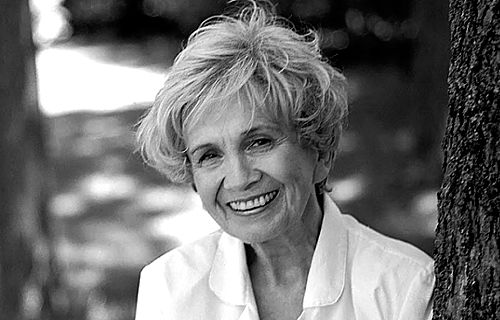There's something elitist about that classification, but what I mean to say is her "literary-ness" means she wasn't, nor could she be, "popular." It is a measure of her abilities as a writer that while her stories make demands on readers, she was immensely popular anyway, largely because--as you can well imagine--the payoff finally was well worth the depth her stories reached. She is demanding, not always easy.
Always there is plot, but never is it linear--a + b = c. "In Friend of My Youth," three stories telescope. One is the narrator's--what she wants to do in writing this story; a second conflict/plot involves her mother's needs, never clearly defined; and the third, the one that demands most of our time as readers, a lifelong plot that seems only tangential to the narrator's story or her mother's, an almost gothic tale about a family committed to an old-time religion that keeps them entirely separate from the society around them. Three plots, three conflicts, three settings, three dilemmas, linked as the writer/narrator tries to measure them for meaning to her own life.
The story, like so many others, goes deep into motivations and decisions not always understandable nor planned. "Friend" is literary fiction.
Her characters are never fully knowable, even though they're fascinating. She loved mystery, but if there are any murder victims in her stories, I don't remember them. Often some mystery is involved in the deaths she records, but of greater interest to Alice Munro than the death themselves is the effects--long term, even generational--on descendants or neighbors or attending community.
What was of greatest joy to her was the ordinary mysteries of our lives. It's as if she wielded a darning needle and not a pen, not because everything in her stories seemed hand-woven, but also because that needle was ever capable of pulling apart nothing less than life itself.
When you finish the story, you don't simply turn the page--she wants you fully taken by what it might have been that made a trip to the five-and-dime as incredible as it somehow was to a woman who can't quite forget nor understands why.
The real matters of "Friend" are a broken engagement, an unwanted pregnancy, an early death, an unlikely second marriage. What weds those events is the gracious, committed joy of her mother's friend, severely wounded but never, seemingly, hurt, a woman held in place by her commitment to a faith whose parameters seem dolefully out-of-fashion--and are.
Munro's women--and most all of her protagonists were (no! are) women--are, often as not, trying their best to figure something out about identity, about who they are and why they are who they are.
Not all of us are engaged in the quest to know ourselves--not all, but most. And most of our pilgrimages into the our own histories take us into areas we can only vaguely ascertain. Alice Munro's "literary" fiction will read best if you tell yourself ahead of time that there are mysteries beyond our ken, even if and when we suffer them ourselves.
It's not knowing answers that ring true to life; it's determining, after passionate pursuit, that the pursuit itself is the human story. To Munro life is as mysterious as it is delightful, or, even better, delightful because it's mysterious.
Let's start there, or so saith this old teacher. Let's begin with the thesis that in Munro's world (often rural Ontario) no answers are cheap or forthcoming, and, isn't that a wonderful thing?
I used to dream abut my mother, and though the details in the dream varied, the surprise in it was always the same. The dream stopped, I suppose, because it was too transparent in its hopefulness, too easy in its forgiveness.
That's the first line of "Friend of My Youth." It could easily be the last. It's the whole blessed tale. It's where we end and where we began.
And in that circle is life itself.
That's where Alice Munro finds her stories--in the middle of what we are.
The old teacher in me is going to page through some of Alice Munro's greatest hits, even though I'm quite sure I'm not going to be talking to people who know the stories. If you would like to read along, go to your local library and pick up a copy of Munro's Selected Stories (1996). I'll pull them all from that collection.
Next time--"Postcard."

No comments:
Post a Comment